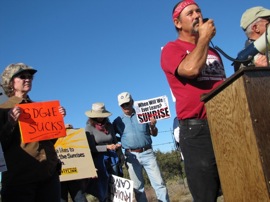Hear the companion radio feature about opposition to the Sunrise Powerlink at The California Report, starting Friday morning.
By Ruxandra Guidi
The road that takes you from the sleepy town of Boulevard into the path of the Sunrise Powerlink is a dusty, unmarked path that’s a couple of miles long. It ends at a gate without a sign, where a guard stands in the hot midday sun. He knows to keep any unauthorized visitors away; there’s a party going on inside, while the protesters make noise for hours outside.

No one yet knows what the Sunrise Powerlink will end up looking like, and at what cost — and that’s just two of the main issues people have with it. Opponents of the giant network of powerlines, towers, and substations, say it will run for 120 miles, through delicate ecosystems and fire-prone areas. Its impact on local residents and wildlife will be irreparable.
On the other hand, SDG&E says its “superhighway” for transporting electrons from remote solar and wind farms to coastal population centers, will respect state and federal lands and go around delicate areas of the desert; that it will generate much-needed jobs while meeting state goals for green energy development. In the process, the California Imperial Valley is being touted as a so-called “mega-region;” a showcase for clean energy production.
But David Elliott sees both sides of this picture with a heavy dose of skepticism. He lives in the mountains north of Boulevard, and belongs to the Manzanita band of the Kumeyaay Nation, a native community whose history and culture is rooted in the desert lands of California, Arizona, and Northern Mexico.
“We’ve been asked to survey thousands of acres that would fall within the Powerlink network,” says Elliott. “We’ve asked SDG&E and its contractors: ‘Where’s the footprint for the proposed towers or lines or roads?’ When we ask that question, they tell us, ‘I don’t know’.”
Despite the fact that no one can yet predict the actual size of the powerline, Elliott believes it is possible to gauge its impact on wildlife and the landscape. But what about the project’s impact on California history? The Kumeyaay and Quechan tribes, among others, know that there are thousands of burial artifacts that have remained undisturbed for generations underground, and they say that federal agencies have given the Powerlink permission to move ahead with construction plans, without proper consultation.
Outside the groundbreaking ceremony, David Elliott was one of two tribal members who showed up to protest the project. This just days after a different group of Native American tribes gained national attention when President Barack Obama settled a historic lawsuit with them, filed by their parents and grandparents 15 years ago. The settlement wasn’t over land or artifacts, but over royalties for oil, gas, grazing and timber rights. Elliott thought about the significance of this news, and saw it, too, with some degree of doubt.
“All the resources that have been extracted from Native American lands over hundreds of years; there’s no amount of money that the government can give to those people, our people, or certain individuals, that would ever be able to repay what they’ve taken out,” said Elliott.
